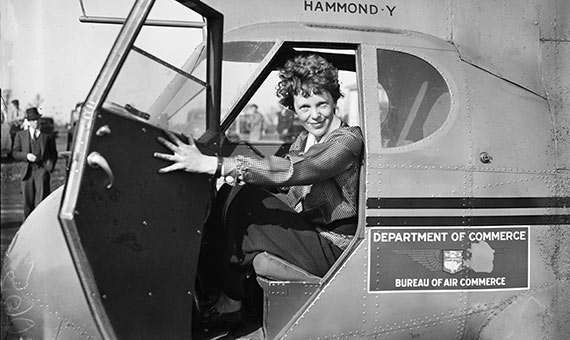On July 2, 1937, there was an exchange of confusing and fragmentary radio communications between the US Coast Guard patrol boat USCGC Itasca, stationed on Howland Island, and the Lockheed Electra 10-E airliner piloted by the celebrated aviator Amelia Earhart on her around-the-world flight. Shortly thereafter, with radio contact already lost, it became apparent that Earhart and her navigator Fred Noonan would never land in Howland according to their flight plan. The search for the remains of the Electra and its crew began one hour later. And eighty years on, it still continues.
Unlike the cases of other famous pilots who disappeared in flight, such as the French writer Antoine de Saint-Exupéry, no one has yet been able to recover a single confirmed artefact from the flight of Earhart and Noonan. The fate of both aviators has captivated the popular imagination for decades, inspiring movies, books, songs and plays; even an episode of Star Trek posed a fanciful solution to the enigma—an alien abduction.

But in addition to the mystery, another circumstance that has undoubtedly fostered interest in the case is the character herself. Thanks to her drive, her charisma and her achievements, Earhart’s reached the status of a celebrity and an icon for the women of her day, with the message that they could achieve what they set out to do. As a young woman, she kept a newspaper scrapbook about women who triumphed in traditionally male professions. When in 1920 she boarded a plane for the first time, she knew she wanted to fly. Two years later, she beat the altitude record for a female pilot at 4,300 metres.
The first woman to fly across the Atlantic
Her leap to fame came in 1928, when she was invited to accompany two male aviators as the first woman to fly across the Atlantic. Earhart said she felt “like a sack of potatoes” because she was not able to pilot the craft. But the repercussion from that feat gave her the backing she needed; advertising contracts and invitations to lectures began to rain down on her and the press spoke of her as the “queen of the air.”

Earhart set more than a dozen records, including that of the first woman to fly solo across the Atlantic, and the first person to do it twice. But her great ambition was to circumnavigate the globe, which she intended to tackle along the longest route on the planet, “as near its waistline as could be.” In 1936 and with the financial support of the University of Purdue, she obtained the appropriate airplane to achieve her goal—the Electra.
The trip began on May 20, 1937 in Oakland, California. After several stages in America, Africa and Asia, on July 2 Earhart and Noonan took off from Lae, Papua New Guinea, en route to Howland, an island halfway between Australia and Hawaii. They never arrived. The incident has historically been attributed to a navigation error, a disastrous communication with the Itasca and the adverse weather that possibly prevented Earhart and Noonan from seeing Howland. The most immediate hypothesis was that the airplane exhausted its fuel and crashed into the sea, where it would remain several kilometres below the waves.
The search of Earhart and Noonan
In 1988, the Delaware-based International Group for Historic Aircraft Recovery (TIGHAR) undertook a search based on the alternative hypothesis that Earhart and Noonan could have landed on the uninhabited atoll of Nikumaroro, 640 kilometres southeast of Howland. This position fits with the last course communicated by the aviator to the Itasca, and the topography of the island would have allowed the landing. Although Nikumaroro was scoured from the air and visited by a group of settlers shortly after the accident without any evidence being detected, the remains of the plane could have been dragged into the sea.

The dozen of expeditions organized by TIGHAR have managed to recover numerous artefacts, including flight jacket buttons, a zipper puller, a shoe heel similar to Earhart’s and even an aluminium panel that matches those used in the Electra—many suggestive traces, no definitive proof. But undoubtedly the remains that have provoked the most discussion are the 13 bones found in Nikumaroro in 1940 and that were then identified as belonging to a male. Although the bones were subsequently lost, new analysis of the data in 1998 and 2016 indicated that they could correspond to a woman, and that they match Earhart’s physique.
Trusting in the clue provided by the bones, TIGHAR is now immersed in a new expedition in Nikumaroro with the support of the National Geographic Society, and with the participation of four dogs from the Institute for Canine Forensics of California, specialized in the location of human bones and able to detect 1,500-year-old remains up to three metres below the ground. If the expedition finds any human remains, the researchers will try to extract DNA to match them with a living relative of Earhart. Perhaps there is still hope of ending eighty years of uncertainty.
Comments on this publication